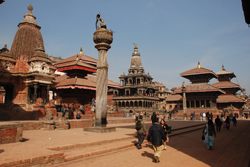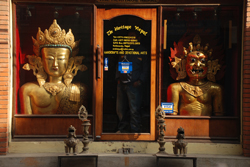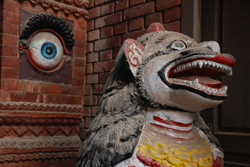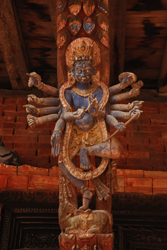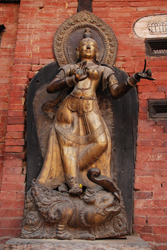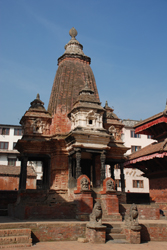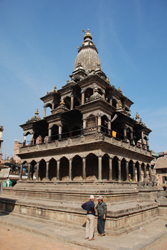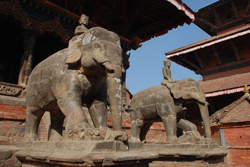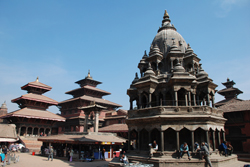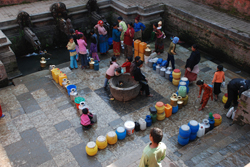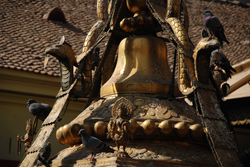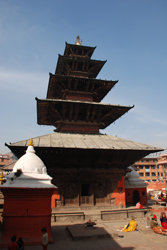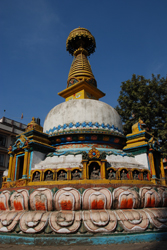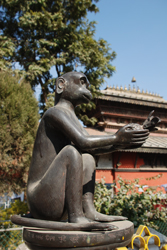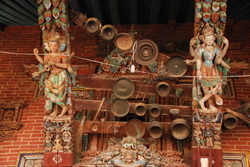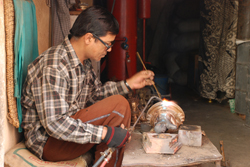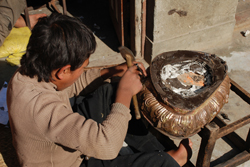Patan: The Kingdom of Artisans
19 January, 2009, 03:20 am in "Nepal"
There are these weird photos of Durbar Square in Kathmandu with huge mountains rising behind it. We determined it was a Photoshop job because you don't see any mountains from Kathmandu. Well, surprise, surprise! Today we could see ranges of huge snow-capped peaks glittering through the haze. I still think the photos are faked-- the mountains were way too large. But you can see the Himalayas from Kathmandu.
Patan is a short bus ride from Kathmandu. It is a town that has been absorbed into Kathmandu though once it was its own kingdom.
We had to walk a little to get to Durbar Square, the historic center of Patan. We began to see the Newari carved windows and some temples. In Patan, you have to be on the lookout for some of the temples because they have a tendency to hide down alleys and side streets. They are easy to walk right by. We almost walked by one, I don't even know what it was called because I couldn't find it on the map. There were 2 painted lions outside an arch. We walked through and found a courtyard with some stupas and an ornate wall of statues, carvings and sculptures.
Patan is a short bus ride from Kathmandu. It is a town that has been absorbed into Kathmandu though once it was its own kingdom.
We had to walk a little to get to Durbar Square, the historic center of Patan. We began to see the Newari carved windows and some temples. In Patan, you have to be on the lookout for some of the temples because they have a tendency to hide down alleys and side streets. They are easy to walk right by. We almost walked by one, I don't even know what it was called because I couldn't find it on the map. There were 2 painted lions outside an arch. We walked through and found a courtyard with some stupas and an ornate wall of statues, carvings and sculptures.
Durbar square was an impressive space filled with red brick buildings with dark wood carved windows and eves. The structures were mainly built between the 14th-18th centuries.
We visited Mul Chowk (There are 3 chowks or courtyards) and noted it seemed to be decorated with dried intestines. Surrounding the courtyard were buildings with painted carved struts, each of a wooden god on his/her mount. At little scene was carved underneath.
We visited Mul Chowk (There are 3 chowks or courtyards) and noted it seemed to be decorated with dried intestines. Surrounding the courtyard were buildings with painted carved struts, each of a wooden god on his/her mount. At little scene was carved underneath.
There were 2 bronze statues of river goddesses in front of Talehu Bhawani temple-- one was on a turtle, the other on a creature which was supposed to be a “mythical crocodile” but had an elephant's trunk and wings.
We wandered around the square looking at the various temples including the Mughal influenced Krishna Mandir, the Vishwanath Temple (to Shiva) with elephant sculptures in front, an octagonal Krishna Temple, and the Jagannarayan Temple.
The Manga Hiti is a sunken area (once a pool), which had several lines of water containers (I presume the owners of them were waiting their turn elsewhere). It is quite sad that in the largest city in Nepal, people must go to the square to get water from public sources.
Next we walked out of Durbar Square and visited the Golden Temple which had impressive metal statues in the courtyard, monkey sculptures in the corners and an upstairs monastery with beautiful paintings.
Up the street was the Kumbeshwar Temple with 5 roofs. It is a tall structure. The area was full of kids playing, stray dogs wandering and some bedraggled sheep and a goat with a limp. At first I thought the animals were for sacrifice. Then I thought they were a bit too pathetic and bedraggled for sacrificial victims. Laundry (probably washed in the sunken water fountain) hung on the fence along one side of the temple.
South of Durbar we visited the Minnath Temple and the Swayambhu Stupa- an ornate but small stupa behind the temple. It also had 4 monkeys making offerings which I thought kind of interesting since they are more known for taking things.
From there we walked down a street full of craftsman's workshops. Patan, or Lalitpur as it was also known, is known for its craftsmen and artisans-- especially the metal workers. According to the tourist info brochure, Lalitpur has produced, “The highest number of talented artists and finest craftsmen ever recorded in Nepalese history. The most famous Newari artists and master craftsmen, like Arniko, Abbay Raj, and Siddhi Raj, were all born in Lalitpur. This was easy to believe as we walked down the street with the sound of hammers and blowtorches in the background as craftsmen worked on small metal sculptures using daylight as they sat in open walled shops.
Comments
- Comments
Powered by My Blog 1.69. Copyright 2003-2006 FuzzyMonkey.net.
Created by the scripting wizards at FuzzyMonkey.net..
(Code modified by Rowshan Dowlatabadi)
Created by the scripting wizards at FuzzyMonkey.net..
(Code modified by Rowshan Dowlatabadi)


